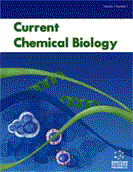Abstract
Abstract: Background: Iron-sulfur clusters are inorganic prosthetic groups composed of only iron and inorganic sulfur atoms. Organisms develop different pathways to sense their local environment and to respond and adapt to changes.
Objective: We focused on Fe-S-containing proteins, which control their activity in response to redox signals by changing the redox state of their cluster. Result: When reduced, these Fe-S cluster-containing sensors are all inactive. As soon as their cluster perceives a signal that induces its oxidation, they switch to an « active state ». Conclusion: This sensing mechanism efficiently helps cells to turn on survival pathways quickly and recover from stressful conditions.Keywords: Fe-S cluster, sensor, redox state, cellular adaptive response, mitoNEET, iron.
Graphical Abstract
Current Chemical Biology
Title:Fe-S Proteins Acting as Redox Switch: New Key Actors of Cellular Adaptive Responses
Volume: 11 Issue: 2
Author(s): Marie-Pierre Golinelli-Cohen*Cécile Bouton*
Affiliation:
- Institut de Chimie des Substances Naturelles, UPR 2301-CNRS, 1 avenue de la Terrasse 91190 Gif-sur-Yvette, Cedex,France
- Institut de Chimie des Substances Naturelles, UPR 2301-CNRS, 1 avenue de la Terrasse 91190 Gif-sur-Yvette, Cedex,France
Keywords: Fe-S cluster, sensor, redox state, cellular adaptive response, mitoNEET, iron.
Abstract: Abstract: Background: Iron-sulfur clusters are inorganic prosthetic groups composed of only iron and inorganic sulfur atoms. Organisms develop different pathways to sense their local environment and to respond and adapt to changes.
Objective: We focused on Fe-S-containing proteins, which control their activity in response to redox signals by changing the redox state of their cluster. Result: When reduced, these Fe-S cluster-containing sensors are all inactive. As soon as their cluster perceives a signal that induces its oxidation, they switch to an « active state ». Conclusion: This sensing mechanism efficiently helps cells to turn on survival pathways quickly and recover from stressful conditions.Export Options
About this article
Cite this article as:
Golinelli-Cohen Marie-Pierre*, Bouton Cécile*, Fe-S Proteins Acting as Redox Switch: New Key Actors of Cellular Adaptive Responses, Current Chemical Biology 2017; 11 (2) . https://dx.doi.org/10.2174/2212796811666170406163809
| DOI https://dx.doi.org/10.2174/2212796811666170406163809 |
Print ISSN 2212-7968 |
| Publisher Name Bentham Science Publisher |
Online ISSN 1872-3136 |
 34
34 2
2
- Author Guidelines
- Bentham Author Support Services (BASS)
- Graphical Abstracts
- Fabricating and Stating False Information
- Research Misconduct
- Post Publication Discussions and Corrections
- Publishing Ethics and Rectitude
- Increase Visibility of Your Article
- Archiving Policies
- Peer Review Workflow
- Order Your Article Before Print
- Promote Your Article
- Manuscript Transfer Facility
- Editorial Policies
- Allegations from Whistleblowers
- Announcements
Related Articles
-
Total Polyphenols and Bioactivity of Seeds and Sprouts in Several Legumes
Current Pharmaceutical Design Isolation and Characterisation of Acetylcholinesterase Inhibitors from Aquilaria subintegra for the Treatment of Alzheimer’s Disease (AD)
Current Alzheimer Research Anticipation in Lynch Syndrome: Where We Are Where We Go
Current Genomics Is the Cytoskeleton an Intracellular Receptor for Adrenomedullin and PAMP?
Current Protein & Peptide Science Thymoquinone a Potential Therapeutic Molecule from the Plant Nigella sativa: Role of Colloidal Carriers in its Effective Delivery
Recent Patents on Drug Delivery & Formulation Roles of Natural Compounds from Medicinal Plants in Cancer Treatment: Structure and Mode of Action at Molecular Level
Medicinal Chemistry Cancer Vaccines for Hormone/Growth Factor Immune Deprivation:A Feasible Approach for Cancer Treatment
Current Cancer Drug Targets Pathophysiology and Pharmacological Targeting of Tumor-Induced Bone Disease: Current Status and Emerging Therapeutic Interventions
Current Medicinal Chemistry Modified-Release Solid Formulations for Colonic Delivery
Recent Patents on Drug Delivery & Formulation Anaesthesia in Cancer Surgery: Can it Affect Cancer Survival?
Current Clinical Pharmacology Reactive Oxygen Species: Physiological Roles in the Regulation of Vascular Cells
Current Molecular Medicine Fighting Diabetes: Lessons from Xenotransplantation and Nanomedicine
Current Pharmaceutical Design Design, Synthesis and Biological Evaluation of a Novel Series of Indole-3- Carboxamide Derivatives for Cancer Treatment as EGFR Inhibitors
Letters in Drug Design & Discovery Novel Anticancer Agents and Targets: Recent Advances and Future Perspectives
Mini-Reviews in Medicinal Chemistry MMP7 Induces T-DM1 Resistance and Leads to the Poor Prognosis of Gastric Adenocarcinoma via a DKK1-Dependent Manner
Anti-Cancer Agents in Medicinal Chemistry The Case for Development of 11-Aza-artemisinins for Malaria
Current Medicinal Chemistry Enzymatic Processing of <i>Omega</i> 3 Long Chain Polyunsaturated Fatty Acid Oils
Current Nutrition & Food Science In Vitro Collapsing Colon Cancer Cells by Selectivity of Disulfiram-Loaded Charge Switchable Nanoparticles Against Cancer Stem Cells
Recent Patents on Anti-Cancer Drug Discovery Can Colorectal Cancer be Prevented or Treated by Oral Hormone Replacement Therapy?
Current Molecular Pharmacology The Evaluation and Utilization of Marine-derived Bioactive Compounds with Anti-obesity Effect
Current Medicinal Chemistry

















.jpeg)








